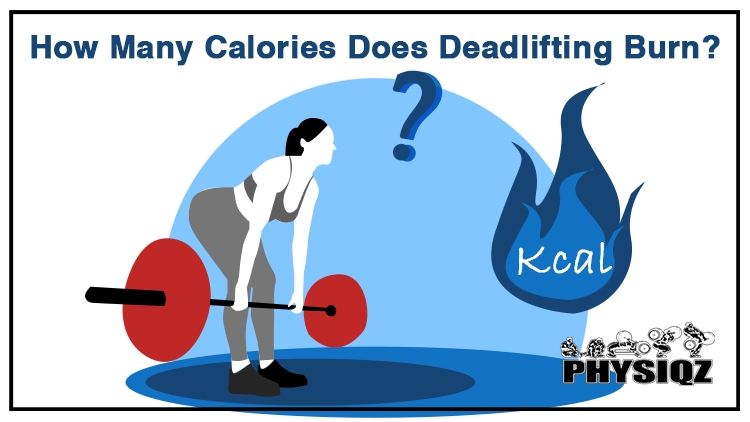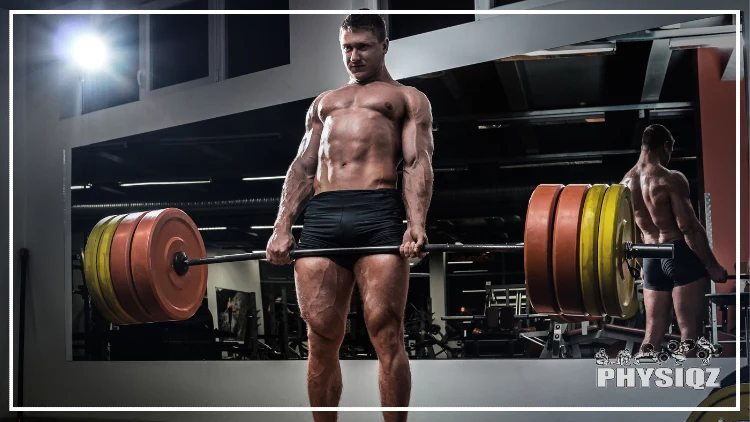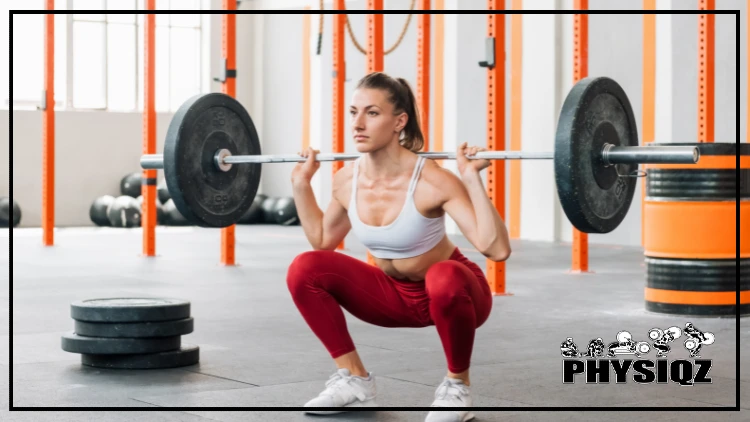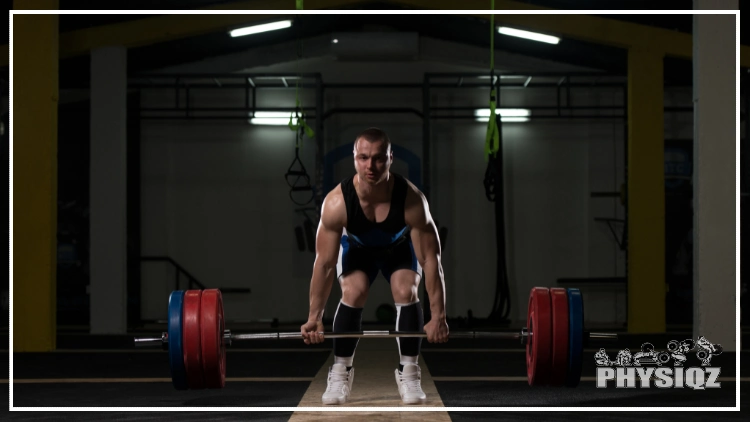
Table of Contents
How many calories does deadlifting burn?
The deadlift is oftentimes considered the “king” or “queen” of all exercise right along with the squat because they’re both large compound movements that offer tons of stimulus and hormonal benefits.
When considering this and how taxing heavy deadlifts are, it’s no surprise deadlifts burn a ton of calories, but how much more does deadlifting burn vs weight lifting exercises such as squats? Can it be caluclated?
What about deadlifts variations like sumo, conventional, or hex bar squats; do they burn more or less calories than normal deadlifts?
Let’s take a look.
How Many Calories Does Deadlifting Burn?
The amount of calories that are burned will really depend on several factors such as the type of deadlift, the weight used and the level of intensity of the lift.
The exact number of calories that are expended may be difficult to pinpoint, however to get some idea, there is a published Harvard study that states that someone with an average weight of 125 pounds engaged in general weightlifting for 30 minutes is expected to burn through 90 kcal.1
There are different variations of deadlifting, as a case in point; there is a standard deadlift and a straight leg deadlift. The standard deadlift is a multi-joint movement that recruits more muscles which means more weight can be hauled leading to a more intense calorie burn than a straight leg deadlift. Using more weight adds intensity and so does a reduction of time rested between sets.

Source: A’s Images via Canva.com18
It should be noted however, that calories burned are not limited to the deadlift session alone. The muscle growth that is induced by this high intensity exercise results in an enhancement of the resting metabolic rate (RMR) which implies that the body continues burning calories long after the session has been completed when the body is at rest.2
After a deadlift workout, the body needs to restore several resources that were depleted such as oxygen levels, removal of lactic acid that had built up, and to create new energy reserves in a process dubbed excess post-exercise oxygen consumption (EPOC) which is calorie intensive.3
Performing deadlifts in the 15-20 rep range based on loads that are 50% of the 1 rep max can consume up to 60 calories as a result of the EPOC process..4 These numbers should convince newbies who may be naysayers to the deadlift to include this versatile compound movement in any beginner hypertrophy program.
How many calories does deadlifting burn? Based on all these factors, it can be assumed that on average anywhere between 150 and 300 kcal are expended for a 30 minute session of deadlifting.
How Many Calories Does 1 Deadlift Burn?
An idea has been established of how many calories are burned during a workout—the number of calories that one deadlift burns can also be inferred based on a 30 minute session that burns 250-300 kcal. Assuming that the lifter is doing 5 reps per set and ends up doing 5 sets of deadlifts.
Based on the assumption that energy is only expended during the actual workout rather than the rest periods, each set of deadlifts should consume 50-60 kcal. In conclusion, one deadlift burns an estimated 10-12 kcal of energy.
Do Deadlift Variations (Sumo, Conventional, Pause DLs, Hex Bar Etc.) Burn More or Less Calories?
As mentioned before, the type of deadlift variations will have an effect on how many calories are burned due to the recruitment of the number of muscles translating into how much weight can be lifted leading to fewer or more calories being burned as a result.
There are a number of deadlift variations that can be done including conventional deadlifts, sumo deadlifts, stiff leg deadlifts and pause deadlifts.
Sumo deadlifts—sumo deadlifts are less challenging than conventional deadlifts because they have a smaller ROM which means the lifter hauls the weight through a smaller distance. Range of motion (ROM) is the spectrum through which a joint or exercise can be moved through or degree of movement that it traverses.5
Sumo deadlifts engage the hips more than they do the back muscles, and are less challenging than conventional deadlifts as they involve less muscle mass and as a result burn less calories than conventional deadlifts.
Stiff leg deadlifts— these are much more taxing on the muscles and central nervous system and are more demanding than the conventional deadlift. It excludes the quads and primarily stimulates the posterior chain.
However, there are limitations into how much weight can be used which means they burn less calories just as dumbbell stiff-legged deadlift which is the most ultimate stiff leg deadlift alternative effective.
Romanian deadlifts—doing these require that the lifter be slightly bent at the knees; they are similar to stiff leg deadlifts. The posterior chain is the primary mover and they tend to use less weight than conventional deadlifts and thus burn less calories.
Pause deadlifts—these deadlifts are similar to conventional deadlifts except there is a momentary pause somewhere between the floor and knees with the pause measured when the bar is motionless. Due to this pause, the deadlift does get challenging which means the lifter is likely not to lift as heavy or in the same rep range. Pause deadlifts will tend to burn slightly more calories than conventional deadlifts.
Hex bar deadlifts—hex bars sometimes referred to as trap bars place less stress on the back and are generally easier and more comfortable to do than a conventional deadlift that uses a barbell.
Studies show that lifters deadlifting with a hex bar are able to lift an average 50 more pounds more than with a conventional barbell allowing for greater mechanical demand on the lifter.6 As long as the lifter can go heavier which they typically can and will than they do with conventional deadlifts, they are likely to burn more calories.
Does Deadlifts or Squats Burn More Calories?
Squats and deadlifts both rival each other for the title of ‘king of the exercises’ with both being compound movements that target multiple muscle groups at the same time—but which of the two burns the most calories?
To determine this, an analysis of what muscles both exercises target would be a start, the weight limits that each exercise can impose and the average volume each exercise is typically done in.

Source: photology2000 via Canva.com19
Deadlifts utilize almost every muscle in the body more so than any other lift. The posterior chain is the primary target for the deadlift which is composed of the glutes, the hamstrings, the erector spinae (muscles that line the spine), rear deltoids and trapezius muscles.7
In addition to this, the core muscles which include the abdominals and obliques, inner thigh muscles, quadriceps, traps and rhomboids are worked.
The deadlift uses a partial ROM of the squat. Deadlift is taxing on the body leaving the body drained, is done with fewer reps and done with lower frequency than squats, but lifters generally go heavier with deadlifts than squats.
Squats on the other hand, are a quadriceps intensive exercise but they also target the glutes, calves, hip flexors, groin muscles, and to a lesser degree, the hamstrings. Squats, if performed with correct form and full ROM, will lead to a higher amount of stress placed on the endocrine system while recruiting a slightly larger mass.
The legs contain a higher amount of slow twitch fibers that are adapted to endurance and strength training because they contract slowly and don’t tire quickly.8
By varying the intensity between heavy training and low intensity work which includes lower weight and higher reps, the metabolic rates can vastly be increased which will lead to higher calorie burn.
How many calories does deadlifting burn? Both squats and deadlifts are efficient at burning calories, but squats have an edge on this, and since they can often be done in more reps, they are a better calorie burner. Merging the two exercises for a squat and deadlift same day routine can work wonders in the calorie department.
How Many Calories Does Weight Lifting Burn?
The amount of calories that deadlifting burns vs calories weight lifting burns depends on factors such as the weight of the person, the intensity of the exercise and the weights used. On average a lifter weighing 125 lbs. can expect to burn 90 kcal from the general weight lifting and 180 kcal from vigorous weightlifting.
Based on the study from Harvard University mentioned earlier, the results catalog moderate and vigorous weight lifting—vigorous weightlifting is when the heart rate is increased exponentially to 70-85 % of the maximum heart rate, breathing becomes hard and fast and it becomes difficult to maintain a conversation; moderate weight lifting has the breathing and heart rate noticeably faster but the person is still able to have a conversation.9
The table below gives a summary of the results from the study detailing the amount of calories that can be expended in 30 minutes for both general and vigorous weightlifting for different weight categories namely: 125 lbs., 155 lbs. and 185 lbs.1

Does Deadlifting Promote Weight Loss?
Deadlifting is excellent for those looking to lose weight not only because they are great at burning calories, but they also engage multiple muscle groups and increase anabolic hormones that promote fat loss and induce muscle growth.

Source: Ibrakovic via Canva.com20
Calorie burner—as mentioned before, someone deadlifting for 30 minutes can expect to burn up to 300 kcal even more than when running, and this is beneficial for fat loss especially if the lifter is exercising proper nutrition with the aim of achieving a calorie deficit making it easier to achieve a 1000 calorie deficit.
Increased metabolic rates—deadlifts are an excellent tool for building muscle across many muscle groups which not only expend more energy but also increase the resting metabolic rate (RMR). This means calories are still being burned hours after the workout has been completed.
Testosterone—performing deadlifts regularly increases the amount of testosterone in the body.10 This is a male sex hormone produced in the testicles but also produced in smaller quantities in the ovaries of women. It helps in muscle repair and inhibits the production of fat cells.
Human growth hormones (HGH)—HGH play vital roles in the body such as muscle growth, strengthening bones, healing tissues and promoting fat loss. When these hormones are low, individuals are likely to be obese. Conversely, deadlifts stimulate the production of HGH which results in the breakdown of fat cells and also stimulates the liver to secrete insulin-like growth factor (IGF-1) that encourages muscle growth.
Deadlifts Calorie Burn Calculator
The amount of calories burned that a deadlift induces is unique to an individual and can be computed using the tool below or manually.
When doing it manually, the key is to have knowledge of the metabolic equivalent of a task (MET). MET will give an indication on the number of calories that can be burned for every hour of exercise per kilogram of body weight.
To use the deadlifts calorie burn calculator, follow the series of steps below.
- The Compendium of Physical Activities has the MET for the big three compound movements including deadlift at 6.0.11
- Next step is to determine what the lifter’s weight is in Kilograms—this is done by dividing the weight in pounds by 2.2. As an example, someone weighing 185 lbs. will weigh 84.09 kg.
- The MET formula is thus :
- Calories (kcal) = MET’s x weight (kg) x time (hours)
For example, to compute the calories burned by a lifter deadlifting for 30 minutes and weighing 170 lbs., the calculation appears below:
6.0 (MET) x (170 lbs. /2 = 77.27kg) x (0.5 hours) = 231.81 kcal.
10 Benefits of Doing Deadlifts
Deadlifts are an excellent compound movement for any lifter to incorporate into their training regimen; it is a staple for many elite bodybuilders and powerlifters and has numerous benefits including weight loss, improves cardio performance, enhances core strength and stability and improves posture.
#1 Weight Loss
As outlined earlier, deadlifts are great for weight loss and those wondering how many calories does deadlifting burn would be pleased to know they burn a substantial amount of calories even when the lifter is at rest during the EPOC process.
Lifters can additionally include high intensity interval training (HIIT) with their deadlift exercise. HIIT is the combination of short bursts of intense working out with lower intensity recovery periods which has been shown to burn up to 30% more calories than alternate exercises.12
#2 Increases Cardio Performance
Deadlifts tend to keep the heart rate elevated thereby giving an excellent cardiovascular workout which can carry on to the treadmill and running in general. Stronger hearts mean athletes can have longer cardio sessions without tiring easily.
#3 Enhance Core Strength and Stability
The core is heavily engaged to provide stability and strength during the deadlift which results in the core muscles becoming stronger. Core muscles are braced to maintain spinal rigidity crucial for a proper deadlift. Having a strong core is beneficial in everyday life and even makes other core-engaging exercises such as the overhead press more efficient to do.
#4 Improves Posture
Deadlifts are great at improving someone’s posture because when they are done with proper form, the shoulder blades must be retracted back, spine remains neutral and hips maintain mobility. This helps the shoulders, hips and spine always remain aligned which can lead to reduced incidences of lower back pain.
Does deadlift stunt growth? As long as they are done correctly and with proper form, they can often help teenagers and young adults establish a proper foundation to grow to be strong adults with proper posture especially since they may tend to spend a lot of time leading inactive sedentary lives.
#5 Enhances Athleticism
As a result of a stronger core enhanced by the deadlift, this carries on to other athletic workouts such as the vertical jump, T-test, medicine ball throw and 40 yard dash.13
#6 Improves Muscle Mass and Strength
When compared to other compound movements that engage many muscle groups, deadlifts allow the lifter to lift very heavy, making them stronger in the hip hinge position (a state where the spine and pelvis remain neutral as the lifter bends forward). This allows for strength adaptations that carry over to compounds such as squats and bench press. In a nutshell, the body’s adaptation to deadlifts is nothing short of raw power, strength and increased performance.
#7 Reduction Of Lower Back Pain
Lower back pain has become rampant in the modern age due to many people leading sedentary lives, sitting behind office desks for long periods, being overweight and having weak cores. Deadlifts rectifies this by building strong backs and core muscles and research shows that deadlifting does alleviate pain and disability in a number of patients who experience lower back pain.14
#8 Increases Bone Density
The growth hormone (HGH) that is produced in increased quantities does not only stimulate muscle growth, but increases the strength of bones. Weight lifting exercises and in particular deadlifts have been demonstrated to increase bone mass which makes them less likely to break especially as individuals get older where they are prone to losing bone density.15
#9 Anabolic Hormones
The recruitment of multiple muscle groups causes a number of hormones to be released such as testosterone and HGH. Having higher levels of these hormones induces muscle growth, strength, inhibits fat storage and improves libido.16
#10 Improves Grip
Deadlifts demand vast amounts of grip to lift heavy weight during the movement which will result in the body adapting and developing a strong grip regardless of whether the lifter is using a hook grip vs mixed grip. Surprisingly, when individuals have weak grip strength, they tend to have greater risk of health problems when they are old, which makes grip a biomarker and indicator for overall health in adults.17
Deadlifts are known to be beneficial compound movements that build massive strength and muscle but what may be little known is how many calories does deadlifting burn vs calories that overall weight lifting burns; the differences should strengthen the case for this exceptional exercise and crown it as the king of exercises.
Frequently Asked Questions About How Many Calories Does Deadlifting Burn
How Many Calories Does Deadlifting Burn in 1 Hour?
On average, deadlifts can burn up to 600 kcal per hour for a vigorous session.
How Many Calories Does Bench Pressing Burn?
Bench pressing on average burns 45 kcal for 15 sets of bench press which translates to up to 500 kcal per hour for a person weighing 185 lbs.
References
1School, H. H. (2021, March 8). Calories burned in 30 minutes for people of three different weights. Retrieved 2022, from <https://www.health.harvard.edu/diet-and-weight-loss/calories-burned-in-30-minutes-for-people-of-three-different-weights>
2J C Aristizabal, J. F. (2014, October 8). Effect of resistance training on resting metabolic rate and its estimation by a dual-energy X-ray absorptiometry metabolic map. Retrieved 2022, from <https://pubmed.ncbi.nlm.nih.gov/25293431/>
3Jeff M. Reynolds, L. K. (2022). Resistance Training and EPOC. Retrieved 2022, from <https://www.unm.edu/~lkravitz/Article%20folder/epoc.html>
4S P Brown, J. M. (1994, August 12). Prediction of the oxygen cost of the deadlift exercise. Retrieved 2022, from <https://pubmed.ncbi.nlm.nih.gov/7932947/>
5Brad J Schoenfeld, J. G. (2020, January 21).Effects of range of motion on muscle development during resistance training interventions: A systematic review. Retrieved 2022, from <https://www.ncbi.nlm.nih.gov/pmc/articles/PMC6977096/>
6Jason Lake, F. D. (2017, October 24). Effect of a Hexagonal Barbell on the Mechanical Demand of Deadlift Performance. Retrieved 2022, from <https://www.ncbi.nlm.nih.gov/pmc/articles/PMC5969032/>
7Wikipedia. (2021, October 11). Posterior chain. Retrieved 2022, from <https://en.wikipedia.org/wiki/Posterior_chain>
8MedlinePlus. (2022, July 8). Is athletic performance determined by genetics? Retrieved 2022, from <https://medlineplus.gov/genetics/understanding/traits/athleticperformance/>
9Prevention, C. f. (2022, June 16). Physical Activity for a Healthy Weight. Retrieved 2022, from <https://www.cdc.gov/healthyweight/physical_activity/index.html>
10Loebel, C. C. (1998, February). Testosterone and Resistance Exercise in Men. Retrieved 2022, from <https://journals.lww.com/nsca-jscr/Abstract/1998/02000/Testosterone_and_Resistance_Exercise_in_Men.12.aspx>
11Loebel, C. C. (2021, September 21). Modeling of Metabolic Equivalents (METs) during Moderate Resistance Training Exercises (2011). Retrieved 2022, from <https://doi.org/10.3390/app11188773>
12Falcone, P. H.-Y. (2015, March). Caloric Expenditure of Aerobic, Resistance, or Combined High-Intensity Interval Training Using a Hydraulic Resistance System in Healthy Men. Retrieved 2022, from <https://journals.lww.com/nsca-jscr/fulltext/2015/03000/Caloric_Expenditure_of_Aerobic,_Resistance,_or.28.aspx>
13Chris Sharrock, J. C. (2011, June). A PILOT STUDY OF CORE STABILITY AND ATHLETIC PERFORMANCE: IS THERE A RELATIONSHIP? Retrieved 2022, from <https://www.ncbi.nlm.nih.gov/pmc/articles/PMC3109894/>
14Berglund, L. A. (2015, July). Which Patients With Low Back Pain Benefit From Deadlift Training? Retrieved 2022, from <https://journals.lww.com/nsca-jscr/fulltext/2015/07000/which_patients_with_low_back_pain_benefit_from.6.aspx>
15Pamela S.Hintona, P. N. (2015, October). Effectiveness of resistance training or jumping-exercise to increase bone mineral density in men with low bone mass: A 12-month randomized, clinical trial. Retrieved 2022, from <https://doi.org/10.1016/j.bone.2015.06.008>
16Shaner, A. A., Vingren, J. L., & Hatfield, D. B. (n.d.). The Acute Hormonal Response to Free Weight and Machine Weight Resistance Exercise. Retrieved from <https://journals.lww.com/nsca-jscr/Fulltext/2014/04000/The_Acute_Hormonal_Response_to_Free_Weight_and.22.aspx>
17Bohannon, R. W. (2019, October 1). Grip Strength: An Indispensable Biomarker For Older Adults. Retrieved 2022, from <https://www.ncbi.nlm.nih.gov/pmc/articles/PMC6778477/>
18A’s Images. Canva. Accessed 15 April 2023. <https://www.canva.com/photos/MAE3Xq2atbA-strong-man-doing-deadlift/>
19photology2000. Canva. Accessed 15 April 2023. <https://www.canva.com/photos/MAFNU4_uMeg-sportswoman-doing-barbell-back-squat/>
20Ibrakovic. Canva. Accessed 15 April 2023. <https://www.canva.com/photos/MADv3s08BmQ-powerlifter-heavy-weight-barbell-exercise-deadlift-in-powerlifting/>